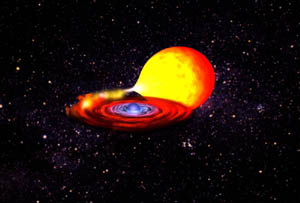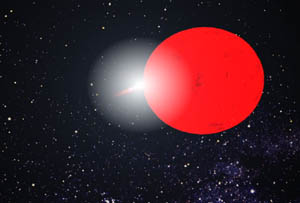Imagine the Universe News - 25 November 2002
Exotic Innards of a Neutron Star Revealed in a Series of Explosions
| 25 November 2002 |
 |
| The neutron star EXO 0748-676 (blue
sphere in the image) is part of a binary star system, with its
companion star (yellow-red sphere in the image) supplying the fuel for
the thermonuclear bursts. During outbursts from the companion,
or when the orbit brings the stars closer together, gas from the
companion star flows toward the neutron star, attracted by its strong
gravity. The flow of gas forms a swirling accretion disk around the
neutron star (represented by the multi-colored swirl around the blue
sphere in the image). The video (8.6 MB QuickTime) is a computer animation illustrating a thermonuclear burst consuming an entire neutron star. Larger Image (Credit: NASA) |
Amidst the fury of 28 thermonuclear blasts on the surface of a neutron star, scientists using the European Space Agency's XMM-Newton X-ray satellite have obtained a key measurement revealing the nature of matter inside these enigmatic objects.
The result, published in the November 7, 2002 issue of Nature, captures for the first time the ratio between such a ultra-dense star's mass and radius in an extreme gravity environment.
The neutron star -- the core remains of a star once bigger than the Sun yet now small enough to fit within the Washington Beltway -- contains densely packed matter under forces that perhaps existed at the moment of the Big Bang but which cannot be duplicated on Earth.� The contents offer a crucial test for theories describing the fundamental nature of matter and energy.
The scientists, a team led by Jean Cottam of NASA Goddard Space Flight Center in Greenbelt, Maryland, probed the neutron star interior by measuring for the first time how light passing through the star's centimeter-high atmosphere is warped by extreme gravity through the process of gravitational redshift.� Strong gravity has an effect on light similar to the more familiar Doppler shift: the light becomes reddened. The extent of the gravitational redshift, as predicted by Einstein, depends directly on the neutron star's mass and radius.� The mass-to-radius ratio, in turn, determines the density and nature of the star's internal matter, called the equation of state.
"It is only during these bursts that the region is suddenly flooded with light and we were able to detect within that light the imprint, or signature, of material under extreme gravitational forces," said Cottam.
The neutron star is part of a binary star system named EXO 0748-676, located in the constellation Volans, or Flying Fish, about 30,000 light year away in the Milky Way galaxy, visible in southern skies with a large backyard telescope.
Neutron stars form when stars several times more massive than the Sun run out of fuel and collapse.� Scientists estimate that neutron stars contain the mass of about 1.4 suns compacted into a sphere only about 10 miles in diameter.� At such density, all the space is squeezed out of the atoms inside the neutron star, and protons and electrons squeeze into neutrons, leaving a neutron superfluid.
By understanding the precise ratio of mass to radius, and thus pressure to density, scientists can determine the nature of this superfluid and speculate on the presence of exotic matter and forces within -- the type of phenomena that particle physicists search for in earthbound particle accelerators.
Cottam and her team determined that EXO 0748-676's mass-to-radius ratio is 0.152 solar masses per kilometer, based on a gravitational redshift measurement of 0.35.� This provides the first observational evidence that neutron stars are indeed made of tightly packed neutrons, as predicted by theory estimating mass-radius, density-pressure ratios.
"Unlike the Sun, with an interior well understood, neutron stars have been like a black box," said Frits Paerels of Columbia University, co-author on the Nature article.� "We have now bored our first small hole into a neutron star.� Now the theorists will have a go at the little sample we have offered them."
More important, said Mariano Mendez of SRON, the National Institute for Space Research in the Netherlands, the third co-author, "We have now established a means to probe the bizarre interior of a 10-mile-wide chuck of neutrons thousands of light years away -- based on gravitational redshift.� With the fantastic light-collecting potential of XMM-Newton, we can now measure the mass-to-radius ratios of other neutron stars, perhaps uncovering a quark star."
A quark star is denser than a neutron star, thus with a different mass-to-radius ratio, in which neutrons are squeezed so tightly that they liberate the subatomic quark particles and gluons that are the building blocks of atomic matter.
To obtain its measurement, the team needed the fantastic radiance provided by thermonuclear bursts, which illuminate matter very close to the neutron star surface where gravity is strongest.
|
Gas from EXO 0748-676's companion star flows toward the neutron star, attracted by its strong gravity.� The flow of gas forms a swirling disk around the neutron star, called an accretion disk.� Thermonuclear bursts arise soon after gas slams onto the neutron star surface.� This gas, pinned to the neutron star by gravity, spreads across the surface.� As more and more gas rains down, pressure builds and temperature climbs until there is enough energy for nuclear fusion.� This ignites a chain reaction that engulfs the entire neutron star within a second.
Periods of bursting, however, are unpredictable events.� The team spotted the 28 bursts during a series of XMM-Newton observations of the neutron star totaling 93 hours.� They measured the spectra of light passing through the neutron star's atmosphere, a centimeter-thick layer which itself hovers only about a centimeter above the neutron star surface.
Because the force of gravity diminishes quickly with distance, scientists can only observe the effects of gravitational redshifting very close to the neutron star surface.� And because X rays are the predominant form of radiation near the surface, scientists require X-ray telescopes with large collecting area to make such measurements.� XMM-Newton has one of the largest X-ray-light-collecting instruments now in space.
ESA's XMM-Newton was launched in December 1999.� NASA helped fund mission development and supports guest observatory time.� NASA Goddard Space Flight Center hosts the U.S. guest visitor support center.� Jean Cottam joins NASA Goddard through a grant from the National Research Council.


